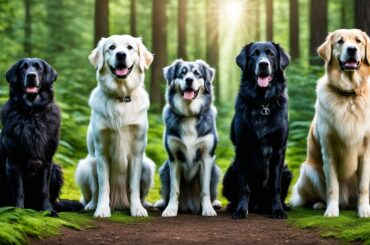The charm of large fluffy dog breeds is undeniable, especially when it comes to finding the perfect furry companion for families. These dogs not only have a majestic appearance with their fluffy coats, but they also have gentle and friendly personalities that make them ideal for households. In this article, we will explore the top large fluffy dog breeds that are perfect for families in the United States.
Key Takeaways:
- Large fluffy dog breeds are a wonderful choice for families looking for a furry companion.
- The Old English Sheepdog, Newfoundland, Samoyed, Saint Bernard, Great Pyrenees, Bernese Mountain Dog, and Siberian Husky are among the top large fluffy dog breeds for families.
- Each breed has unique characteristics and care requirements, so consider grooming needs, exercise requirements, and temperament when choosing the best large fluffy dog breed for your family.
- Regular grooming and exercise are important for these breeds to keep them healthy and happy.
- Remember to research and find a reputable breeder or consider adopting from a rescue organization when adding a large fluffy dog to your family.
Old English Sheepdog
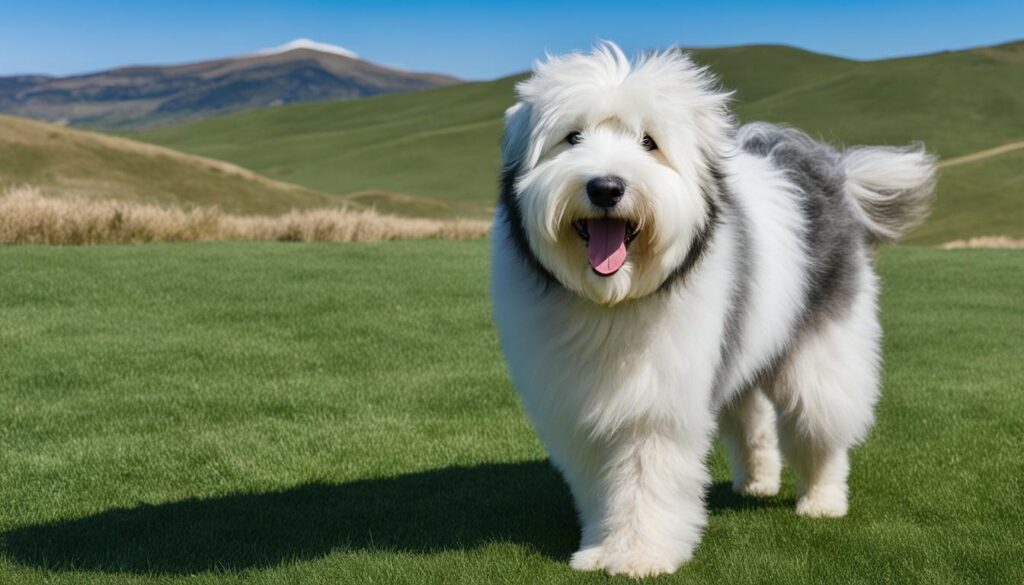
The Old English Sheepdog is a big, shaggy bundle of love that is perfect for family life. Despite its name, this breed is relatively young, dating back to the late 1700s. They are known for their friendly and enthusiastic nature. Regular grooming, including thorough brushing a few times a week, is necessary to keep their long, beautiful coat knot-free.
When it comes to large fluffy dog breeds, the Old English Sheepdog is undeniably popular among families. With their endearing appearance and lovable personality, these dogs quickly become cherished family members. Their large, shaggy coat adds to their charm, but it also requires regular maintenance to keep it looking its best.
The Old English Sheepdog’s origins can be traced back to England in the 18th century, where they were primarily used for herding livestock. Over the years, they transitioned into beloved companions known for their kindness and affection towards both adults and children.
One of the defining features of the Old English Sheepdog is their trademark dense and fluffy coat. It requires regular brushing to prevent matting and tangling. Aim to brush their coat at least three times a week to keep it knot-free and healthy. Additionally, occasional visits to a professional groomer may be necessary to maintain their coat’s overall appearance.
Aside from regular grooming, the Old English Sheepdog thrives in a loving and active family environment. They enjoy participating in family activities and are known to be excellent playmates for children. Their friendly and enthusiastic nature makes them an ideal choice for families looking for a devoted and loyal furry companion.
| Traits | Care |
|---|---|
| Friendly | Regular grooming |
| Enthusiastic | Thorough brushing a few times a week |
| Devoted | Ocassional professional grooming |
| Loyal | Active family environment |
Newfoundland
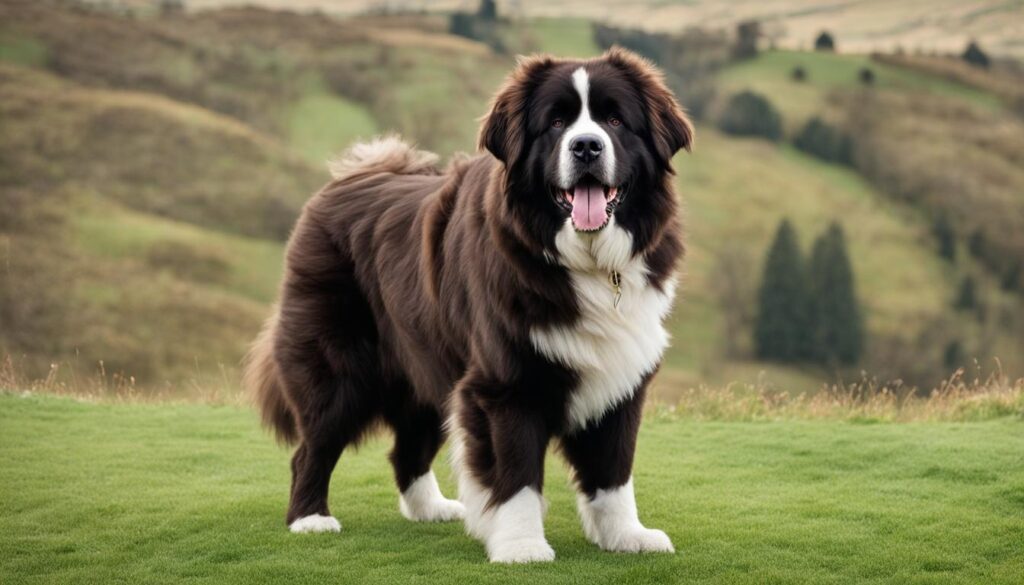
The Newfoundland is a sweet and soulful big fluffy dog breed that is also an excellent swimmer. This Canadian breed has a massive lung capacity, webbed toes, and a water-resistant coat. They were historically used as shipboard dogs for sea rescues. However, they do shed and drool occasionally, so weekly grooming is necessary to keep their coat in good condition.
Characteristics of the Newfoundland Breed:
- Size: The Newfoundland is a large breed, usually weighing between 100-150 pounds.
- Coat: Their double coat consists of a thick, waterproof outer layer and a soft, insulating undercoat.
- Temperament: They are known for their gentle and patient nature, making them great companions for families, including children.
- Swimming Abilities: Newfoundlands have webbed toes and an innate swimming ability, making them excellent water rescuers.
“The Newfoundland is not only large and fluffy, but also possesses a gentle and loving disposition. Their natural swimming ability and history as shipboard rescue dogs further highlight their exceptional traits.”
Grooming Needs:
To keep the Newfoundland’s coat in good condition, regular grooming is necessary. Here are some grooming tips:
- Brushing: Weekly brushing helps to remove loose hair and prevent mats and tangles from forming.
- Trimming: Occasional trimming of the hair around the ears, paws, and tail can help maintain cleanliness and hygiene.
- Bathing: Bathing should be done as needed, using a gentle dog shampoo to avoid drying out the skin.
- Nail Care: Regular nail trimming is essential to prevent overgrowth and ensure comfortable movement.
By following these grooming practices, owners can keep their Newfoundland’s coat healthy and beautiful.
| Pros of owning a Newfoundland | Cons of owning a Newfoundland |
|---|---|
| • Gentle and patient temperament | • Moderate shedding |
| • Excellent with children | • Occasional drooling |
| • Great swimming abilities | • Requires regular grooming |
Samoyed
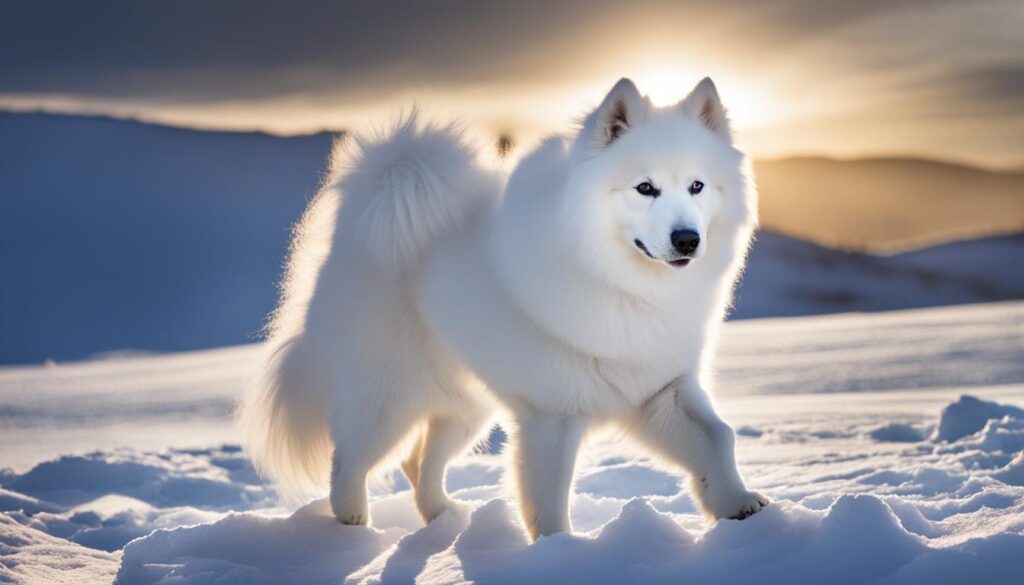
The Samoyed is a sociable and intelligent large fluffy dog breed that hails from Siberia. They were bred to be cuddlers and were used to keep their humans warm on frozen Arctic nights. Their friendly and outgoing nature makes them a popular choice for families looking for a loyal and affectionate companion.
This breed is deeply social and thrives on human companionship. They require lots of time and attention from their owners to prevent them from becoming bored or anxious. A Samoyed will happily spend hours playing with children, making them an ideal family dog.
“The Samoyed’s sociable nature and love for human interaction make them a wonderful choice for families. They are known for their gentle and patient temperament, especially with children. This breed truly thrives as part of a family and will do anything to keep their loved ones happy and warm.”
In terms of grooming, be prepared for regular brushing sessions. Samoyeds have a dense double coat that requires regular maintenance to keep it in pristine condition. They shed consistently throughout the year, regardless of the season. Brushing not only helps to remove loose fur but also prevents matting and tangles.
Despite their luxurious coat, Samoyeds are not hypoallergenic. Their dander and fur can still trigger allergies in sensitive individuals. However, many people with mild allergies find that they can still live comfortably with a Samoyed by managing their environment and practicing good hygiene.
Overall, the Samoyed is a wonderful large fluffy dog breed that brings joy and happiness to any family. Their friendly and sociable nature, coupled with their striking appearance, makes them a beloved choice for families around the world.
Distinguishing Features of Samoyed:
- Size: Large
- Coat: Thick and fluffy, double-layered
- Temperament: Friendly, sociable, and gentle
- Grooming: Regular brushing and shed management
- Activity Level: Moderate
| Pros | Cons |
|---|---|
| Friendliness and sociability | High grooming needs |
| Excellent with children | Regular shedding |
| Loyal and devoted | May not be suitable for individuals with severe allergies |
Saint Bernard
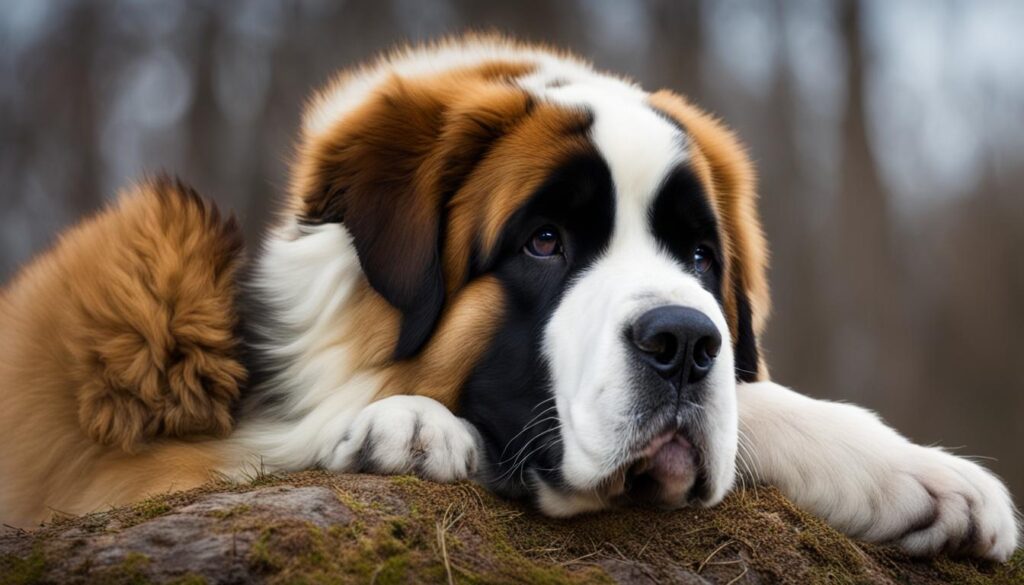
The Saint Bernard is a famously large and gentle breed that is considered one of the best big fluffy dog breeds. Known for their iconic role in the old family film, Beethoven, these dogs capture hearts with their imposing size and lovable nature. Originating from Europe’s snowy Alps, Saint Bernards have a rich history of rescuing travelers in harsh weather conditions.
What makes Saint Bernards particularly wonderful for families with small children is their understanding, patience, and placid temperament. These dogs are known for their gentle and tolerant nature, making them excellent companions for kids. They are often depicted as friendly giants due to their calm and relaxed demeanor.
To keep their large fluffy coats in good condition, weekly brushing sessions are recommended. This helps manage shedding and keeps their fur free from tangles and mats. With proper grooming and care, Saint Bernards maintain their majestic appearance and remain soft and cuddly.
Key Features of Saint Bernards:
- Large and gentle breed
- Perfect for families with small children
- Known for their understanding, patience, and placid nature
- Require weekly brushing to manage shedding
Overall, Saint Bernards are an excellent choice for families seeking a loving and large fluffy dog breed. Their friendly and patient nature, combined with their impressive size, makes them a delightful addition to any household.
Great Pyrenees

The Great Pyrenees is a noble and courageous large fluffy dog breed that was bred to guard sheep on the European mountain range. They are known for their majestic appearance, with a dense double coat that keeps them warm in cold climates. These giants have a gentle and calm temperament, making them excellent family pets.
Despite their gentle nature, Great Pyrenees can be independent and stubborn during training. Early socialization and consistent positive reinforcement are essential to ensure they grow up to be well-behaved companions.
Care and Grooming
The Great Pyrenees has a thick, water-resistant coat that requires regular maintenance. They shed heavily twice a year, typically during spring and fall. During shedding seasons, daily brushing is necessary to manage their loose fur. Outside of shedding seasons, weekly brushing will suffice to keep their coat in good condition.
Additionally, their ears should be checked regularly for signs of infection and cleaned as needed. Proper dental care, including regular brushing and dental check-ups, is also important to maintain their oral hygiene.
Size and Appearance
Great Pyrenees dogs have powerful bodies and can reach heights of over 32 inches and weigh more than 100 pounds. They have a stocky build with a broad chest, strong neck, and muscular limbs. Their coat is typically white or a pale shade, with occasional patches of gray, tan, or red markings.
Temperament
Bred to be guardians, Great Pyrenees dogs are naturally protective and watchful. They are loyal to their families and have an inherent instinct to protect them. However, they can also be reserved or aloof with strangers. Early socialization is essential to ensure they develop good manners and become comfortable in various social situations.
“Great Pyrenees are known for their steadfast loyalty and make excellent companions and watchdogs. With their gentle yet protective nature, they are truly remarkable dogs.”
Overall, the Great Pyrenees is a magnificent breed that thrives in families where they can devote themselves to their loved ones with their unwavering loyalty and protective nature. Their independent spirit and majestic appearance make them stand out among other large fluffy dog breeds.
Bernese Mountain Dog

The Bernese Mountain Dog is a large and powerful breed with a silky coat. Originating from Swiss farms, these dogs were originally used as farm dogs. They have a rich history of hard work and are happiest when they have a job to do. Affectionate and intelligent, Bernese Mountain Dogs make wonderful companions for families. Their thick double coat requires weekly brushing to keep it in top condition.
Here are some key characteristics of the Bernese Mountain Dog:
Temperament: Bernese Mountain Dogs are known for being friendly, gentle, and affectionate. They are great with children and other pets, making them an excellent choice for families.
Size: These dogs are considered large, with males typically weighing between 80 and 115 pounds, and females weighing between 70 and 95 pounds. They stand at a height of around 23 to 27.5 inches.
Coat: Bernese Mountain Dogs have a long, silky, and thick coat that requires regular grooming to prevent matting and keep it looking its best. They have a striking tricolor pattern of black, white, and rust markings.
Activity Level: While they are not the most energetic breed, they do require daily exercise to keep them healthy and prevent obesity. They enjoy activities such as walks, hikes, and playtime in a secure area.
If you’re considering adding a Bernese Mountain Dog to your family, take into account the amount of space they require. These dogs thrive in homes with large yards where they can roam and play. They are adaptable and can do well in both rural and suburban environments.
| Pros | Cons |
|---|---|
| Friendly and gentle nature | High grooming needs |
| Good with children and other pets | Potential health issues |
| Hardworking and intelligent | Require ample exercise |
| Beautiful tricolor coat | Shorter lifespan (around 6 to 8 years) |
Overall, the Bernese Mountain Dog is a magnificent large fluffy breed that thrives in family settings. Their gentle nature, hardworking temperament, and striking appearance make them a popular choice among dog lovers.
Siberian Husky
The Siberian Husky is a mischievous and active large fluffy dog breed that was originally developed by the Chukchi people for sled pulling. They have strong endurance and need regular exercise, including running in a secure space. Despite their fluffy appearance, they are relatively low-maintenance when it comes to grooming and only need regular brushing.
If you’re looking for a high-energy furry friend that loves adventure, the Siberian Husky might be the perfect choice for you. This breed is known for its lively and playful nature, making them great companions for active individuals or families.
With their striking blue or multi-colored eyes and double-layered thick coat, Siberian Huskies are undeniably beautiful. Their coat comes in a variety of colors, including black, white, gray, red, and sable. The dense fur helps protect them from harsh weather conditions, making them well-suited for cold climates.
However, it’s important to note that Siberian Huskies are known escape artists and can be quite independent. They have a strong prey drive and may be prone to chasing small animals. Therefore, a securely fenced yard is essential to keep them safe.
Key Characteristics of Siberian Huskies
- Size: Medium to large
- Weight: Males typically weigh between 45-60 pounds, while females weigh between 35-50 pounds
- Temperament: Friendly, alert, and outgoing. They are social dogs that enjoy the company of humans and other dogs.
- Exercise Needs: High. Siberian Huskies have a lot of energy and require regular exercise to keep them mentally and physically stimulated.
- Grooming: Moderate. Regular brushing helps keep their coat healthy and prevents matting. They shed heavily twice a year.
“Siberian Huskies are known for their mischievous nature and love for adventure. They make great companions for active individuals or families.”
Training Tips for Siberian Huskies
Training a Siberian Husky can be a rewarding experience, but it requires consistency and patience. Here are some tips to help you train your fluffy friend:
- Start early: Begin training your Siberian Husky from a young age. Early socialization and obedience training will help them become well-rounded dogs.
- Positive reinforcement: Use positive reinforcement techniques such as treats, praise, and play to motivate and reward your Husky for good behavior.
- Be firm but gentle: Siberian Huskies are intelligent but can be stubborn. It’s important to establish yourself as the leader while using gentle and consistent training methods.
- Exercise before training: A tired Husky is more likely to focus and pay attention during training sessions. Make sure to provide plenty of physical exercise before training sessions.
- Consistency is key: Be consistent with your commands, expectations, and routines. This will help your Husky understand what is expected of them.
By following these training tips, you can raise a well-behaved and obedient Siberian Husky that will bring joy and companionship to your family.
| Pros | Cons |
|---|---|
|
|
Wrapping Up
In conclusion, large fluffy dog breeds are the perfect choice for families in search of a furry companion. These majestic and gentle dogs bring a delightful presence into any household. From the Old English Sheepdog to the Siberian Husky, each breed offers its own unique characteristics and care requirements.
When selecting the best large fluffy dog breed for your family, it is important to consider several factors. Grooming needs should be taken into account, as some breeds require regular brushing to maintain their luxurious coats. Additionally, exercise requirements vary among breeds, so it is essential to choose a breed that aligns with your family’s activity levels. Lastly, temperament plays a crucial role in a family dog, with some breeds better suited for households with small children.
By considering these aspects and conducting thorough research, families can find their ideal large fluffy dog breed and experience the joy of having a loyal and loving furry companion. Whether it’s the gentle demeanor of an Old English Sheepdog or the mischievous spirit of a Siberian Husky, these fluffy dog breeds for families bring happiness and companionship that will last a lifetime.
FAQ
What are some popular large fluffy dog breeds?
Some popular large fluffy dog breeds include the Old English Sheepdog, Newfoundland, Samoyed, Saint Bernard, Great Pyrenees, Bernese Mountain Dog, and Siberian Husky.
What makes the Old English Sheepdog a great choice for families?
The Old English Sheepdog is known for its friendly and enthusiastic nature, making it a perfect furry companion for families. Additionally, their long, beautiful coat adds to their majestic appearance.
Are Newfoundland dogs hypoallergenic?
No, Newfoundland dogs are not considered hypoallergenic. Although they have a water-resistant coat, they do shed and drool occasionally. Regular grooming is necessary to keep their coat in good condition.
What makes the Samoyed breed unique?
The Samoyed is a sociable and intelligent large fluffy dog breed. They were bred to be cuddlers and were used to keep their humans warm on frozen Arctic nights. However, they do shed consistently throughout the year, so regular brushing is necessary.
Why are Saint Bernards considered great for families?
Saint Bernards have a gentle and placid nature, making them an excellent choice for households with small children. They are patient and understanding, making them great family pets. Weekly brushing is recommended to manage their shedding.
What is unique about the Great Pyrenees breed?
The Great Pyrenees is a noble and courageous large fluffy dog breed that was bred to guard sheep on the European mountain range. They are independent-natured and can be stubborn during training. Regular brushing is necessary to manage their shedding.
What are the characteristics of the Bernese Mountain Dog?
The Bernese Mountain Dog is a large and powerful breed with a silky coat. They are hard workers and thrive when given a job to do. They are affectionate and intelligent, requiring regular brushing to maintain their thick double coat.
Are Siberian Huskies high-maintenance when it comes to grooming?
No, Siberian Huskies are relatively low-maintenance when it comes to grooming. Despite their fluffy appearance, they only need regular brushing to keep their coat in good condition. However, they do require regular exercise and a secure space to run.
What are the benefits of choosing a large fluffy dog breed for a family?
Large fluffy dog breeds have a majestic appearance, friendly personalities, and gentle nature, making them wonderful additions to households. They are ideal for families looking for a furry companion that will fit well into their family dynamic.




